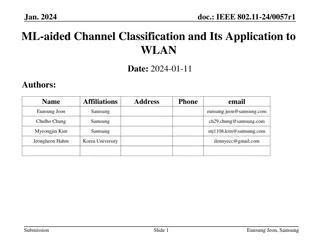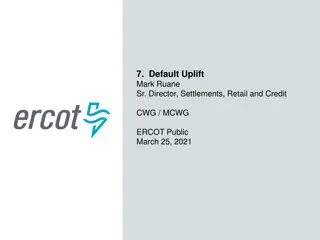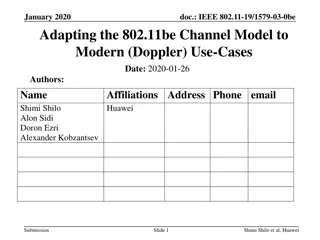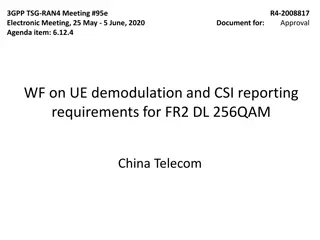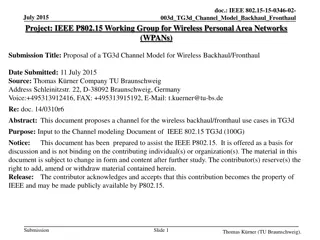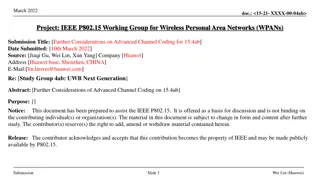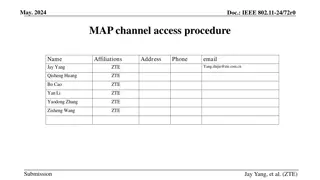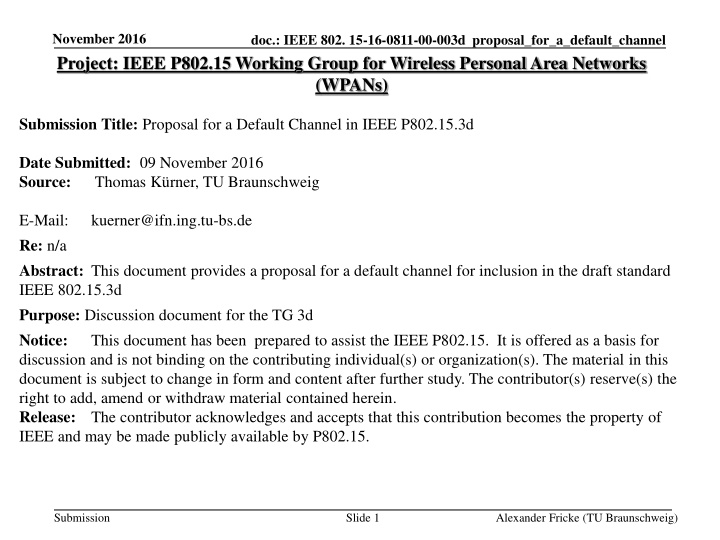
Proposal for Default Channel in IEEE P802.15.3d
This document presents a proposal for a default channel in IEEE P802.15.3d standard that aims to define a channel available for all use cases worldwide with specific bandwidth and considerations to minimize overlap with passive services like Radio Astronomy and Earth Exploration Satellite Services. The proposal outlines requirements, boundary conditions, and identifies potential spectrum parts based on the Radio Regulations.
Download Presentation

Please find below an Image/Link to download the presentation.
The content on the website is provided AS IS for your information and personal use only. It may not be sold, licensed, or shared on other websites without obtaining consent from the author. If you encounter any issues during the download, it is possible that the publisher has removed the file from their server.
You are allowed to download the files provided on this website for personal or commercial use, subject to the condition that they are used lawfully. All files are the property of their respective owners.
The content on the website is provided AS IS for your information and personal use only. It may not be sold, licensed, or shared on other websites without obtaining consent from the author.
E N D
Presentation Transcript
November 2016 doc.: IEEE 802. 15-16-0811-00-003d proposal_for_a_default_channel Project: IEEE P802.15 Working Group for Wireless Personal Area Networks (WPANs) Submission Title: Proposal for a Default Channel in IEEE P802.15.3d Date Submitted: 09 November 2016 Source: Thomas K rner, TU Braunschweig E-Mail: Re: n/a Abstract: This document provides a proposal for a default channel for inclusion in the draft standard IEEE 802.15.3d Purpose: Discussion document for the TG 3d Notice: This document has been prepared to assist the IEEE P802.15. It is offered as a basis for discussion and is not binding on the contributing individual(s) or organization(s). The material in this document is subject to change in form and content after further study. The contributor(s) reserve(s) the right to add, amend or withdraw material contained herein. Release: The contributor acknowledges and accepts that this contribution becomes the property of IEEE and may be made publicly available by P802.15. kuerner@ifn.ing.tu-bs.de Submission Slide 1 Alexander Fricke (TU Braunschweig)
November 2016 doc.: IEEE 802. 15-16-0811-00-003d proposal_for_a_default_channel Proposal for a Default Channel in IEEE P802.15.3d Thomas K rner TU Braunschweig Submission Slide 2 Thomas K rner (TU Braunschweig)
November 2016 doc.: IEEE 802. 15-16-0811-00-003d proposal_for_a_default_channel Requirements and Boundary Conditions For the THZ PHY channelization plan a default channel has to be defined The default channel should be available for all use cases in all regions of the world If possible the bandwidth of the default channel should be 4.32 GHz The default channel should should selected in such a way, that the overlap with the spectrum used by passive services is minimum: Overlap with spectrum from Radio Astronomy is less critical, due to the operations of radio telescopes in a very view remote areas, where the use of device operating in that freqeuncy band can be prohibited. Overlap with Earth Exploration Satellite Services (EESS) may be critical. To avoid any possible restrictions, the channel should be in spectrum regions, where no sharing with EESS is necessary Slide 3 Submission Thomas K rner (TU Braunschweig)
November 2016 doc.: IEEE 802. 15-16-0811-00-003d proposal_for_a_default_channel Possible Spectrum Parts based on FN 5.565 of the Radio Regulations 5.565 The following frequency bands in the range 275-1 000 GHz are identified for use by administrations for passive service applications: radio astronomy service: 275-323 GHz, 327-371 GHz, 388-424 GHz, 426-442 GHz, 453-510 GHz, 623-711 GHz, 795-909 GHz and 926-945 GHz; Earth exploration-satellite service (passive) and space research service (passive): 275-286 GHz, 296- 306 GHz, 313-356 GHz, 361-365 GHz, 369-392 GHz, 397-399 GHz, 409-411 GHz, 416-434 GHz, 439-467 GHz, 477-502 GHz, 523-527 GHz, 538-581 GHz, 611-630 GHz, 634-654 GHz, 657-692 GHz, 713-718 GHz, 729-733 GHz, 750-754 GHz, 771-776 GHz, 823-846 GHz, 850-854 GHz, 857-862 GHz, 866-882 GHz, 905-928 GHz, 951-956 GHz, 968-973 GHz and 985-990 GHz. The use of the range 275-1 000 GHz by the passive services does not preclude use of this range by active services. Administrations wishing to make frequencies in the 275-1 000 GHz range available for active service applications are urged to take all practicable steps to protect these passive services from harmful interference until the date when the Table of Frequency Allocations is established in the above-mentioned 275-1 000 GHz frequency range. All frequencies in the range 1 000-3 000 GHz may be used by both active and passive services. (WRC-12) In the frequency band 275-321 GHz the following bands do not have to be shared with EESS: 286-296 GHz 306-313 GHz Submission Slide 4 Thomas K rner (TU Braunschweig)
November 2016 doc.: IEEE 802. 15-16-0811-00-003d proposal_for_a_default_channel Possibilities within the Proposed TG3d Channel Plan Excerpt of the Channel Plan: CHNL_ID 15 16 17 18 19 20 21 26 27 40 41 42 43 52 53 54 Bandwidth 2.16 2.16 2.16 2.16 2.16 2.16 2.16 2.16 2.16 4.32 4.32 4.32 4.32 8.64 8.64 8.64 Start frequencya 282.96 285.12 287.28 289.44 291.6 293.76 295.92 306.72 308.88 282.96 287.28 291.6 295.92 278.64 287.28 295.92 Center frequency 284.04 286.2 288.36 290.52 292.68 294.84 297 307.8 309.96 285.12 289.44 293.76 298.08 282.96 291.6 300.24 Stop frequencya 285.12 287.28 289.44 291.6 293.76 295.92 298.08 308.88 311.04 287.28 291.6 295.92 300.24 287.28 295.92 304.56 Channels marked as green do not overlap with EESS spectrum Submission Slide 5 Thomas K rner (TU Braunschweig)
November 2016 doc.: IEEE 802. 15-16-0811-00-003d proposal_for_a_default_channel Assessment of the remaining Possibilities Among the possible channels the channels with CHNL_ID 41 and 42 have a bandwidth of 4,32 GHz The minimum separation from protected EESS bands is 1,28 GHz for the channel with CHNL_ID 41 (at the ower end) and 0.08 GHz for the channel with CHNL_ID 42 (at the upper end) The channel with CHNL_ID 41 is proposed as the default channel Submission Slide 6 Thomas K rner (TU Braunschweig)




